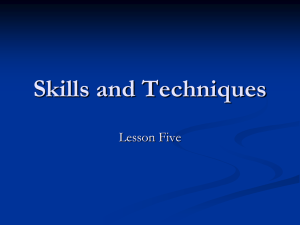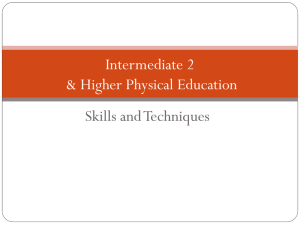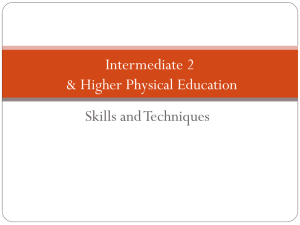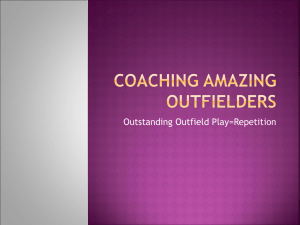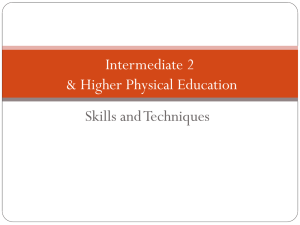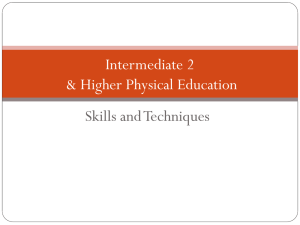HIgher revision SandT - Bridge of Don Academy
advertisement
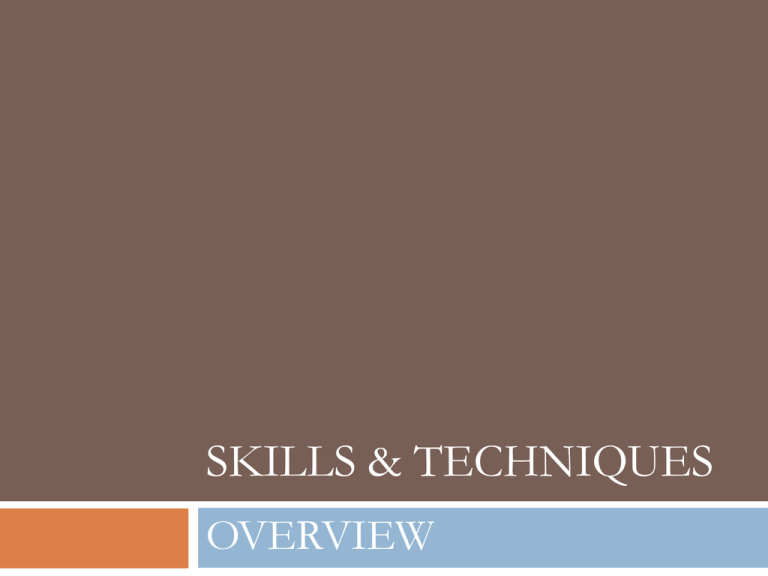
SKILLS & TECHNIQUES OVERVIEW Today and tomorrow we will… Identify the main content Investigate previous questions Create a Skills and Techniques mind map Structure our response to a question Answer a question with our partner Skills and Techniques Cycle of Analysis Analysis Of Overall Performance Reassess Performance Continue to Develop Identified Weakness Analysis of Identified Weakness Plan long & short term targets Progress Check Develop Identified weakness Key Message - Can you tell me what you did at each stage? How did we analyse our performance? 1. Observed video of model performer to develop our knowledge and understanding of effective court movement and what makes a stroke effective. 2. Compared my court movement during competitive games to that of a model performer. 3. Assessed the variety and effectiveness of my strokes in a competitive game. Discussed with my class teacher what my main weakness was. Analysis Of General Performance 4. 5. 6. Assessed the accuracy of overhead clear in closed environment using hoop test. Analysis Of General Performance Assessed placement of overhead clear during competitive game (open environment) using scatter diagram. Observed video of model performer to develop knowledge and understanding of the subroutines involved. Broke overhead clear down into preparation, action, recovery. Analysis of Identified Weakness 7. Compared overhead clear to that of a model performer using movement analysis observation schedule. Stop – Traffic Light How to Collect Data Regarding Your Performance Different methods of collecting initial data (on your whole game) Different methods of collecting focussed data (on your specific weakness) Why do we collect data Why do we do it specific ways/why they are appropriate methods How do these ways give accurate/valid data Key Message - Can you tell me? Possible Higher Questions Describe two methods you used to gather information on your performance. Select one of the following approaches. Describe how you gathered information about your chosen skill or technique using this approach? i. Mechanical Analysis ii. Movement Analysis iii. Consideration of quality (4) Describe, in detail, the methods you used to gather information on your level of performance. Explain why these methods were appropriate. (6) Describe, briefly, how you gathered data/information about your performance in this selected skill or technique. Give specific details of how your performance compared to that of a model/skilled performance. (6) What information about your performance were you able to obtain using one of the following methods of analysis? i. Mechanical Analysis ii. Movement Analysis iii. Consideration of quality (4) Explain the benefits of considering a model/skilled performance when learning or developing this skill or technique. (4) (4) Intermediate 2 Questions Describe one method you used to collect data about your whole performance. (4) Now describe one method you used to collect data about a specific skill in your performance. (3) Explain why both the above methods were appropriate. (4) Describe the methods you used to analyse the weakness identified in Part (a). (4) How did you collect information on the skill or technique chosen Part (a)? (4) Using one of the following: i. Mechanical Analysis ii. Movement Analysis iii. Consideration of quality give details of how you gathered information on your chosen weakness. (4) How did identified weakness effect performance? Analysis of Specific Weakness Plan long & short term targets Identified from assessing variety and effectiveness of strokes that overhead clear was a weakness. What did you initially identify as being wrong? Discuss what the information gathered by the Hoop Test showed with regards the accuracy of your overhead clear. Analysis of Specific Weakness Discuss what the information gathered by the Scatter Diagram told you about the placement of your overhead clear shots. Discuss what you discovered about your performance at the preparation, action and recovery stages when you compared yourself to a model performer. Give specific performance examples to explain how the factors identified at each of the above stages affected your performance. Plan long & short term targets Stop – Traffic Light How weakness effected Performance Describe the skill and explain its purpose. Explain what each of the specific observation schedules highlighted. Explain why the skill was considered to be a weakness and how the weakness effected your performance in games. Key Message - Can you tell me? Possible Questions From your experience in one activity, describe a complex skill or technique you have attempted to develop. Explain why you found this skill or technique difficult to perform . (4) Discuss the results of the information gathered in Part (a) (analysis of performance). Make specific reference to how your whole performance was affected. (6) Intermediate 2 Questions Describe the strengths and weaknesses in your performance. (4) Describe one skill or technique that you regard as a weakness in your performance. (4) Describe your performance in relation to the skilled performance in Part (a). (4) What effect did the skill or technique that was in need of improvement have on your performance? (4) Choose a skill or technique that you found difficult to perform. Describe the specific part(s) that you had difficulty with. (4) Stages of Skill Learning Analysis of Specific Weakness Plan long & short term targets Cognitive Planning Associative Practice Autonomous Automatic Cognitive Stage During the Cognitive Stage, you find out what the skill involves – work out the subroutines. Preparation Action Recovery Even although some of the subroutines involved in the skill maybe new, it does not mean that you are at the beginner level in badminton. Beginner Level Badminton Player After establishing the different subroutines you make your first attempts at learning the skill Errors are likely to be common during the Cognitive Stage. As a result of this you will need lots of advice and encouragement Cognitive Stage During the Cognitive Stage, I found out exactly what the overhead clear involved. To do this I observed a model performing playing the stroke. I was then able to break the skill down into three phases: 1. Preparation, 2. Action, 3. Recovery This enabled me to identify each of the subroutines that make up the skill. By doing this I had a clear understanding of the movements I had to perform in order to play an effective overhead clear. Even although some of the subroutines involved in the overhead clear were new, I wasn’t a badminton beginner, I had some previous experience of the activity. After establishing the subroutines involved I made my first attempts at performing the skill by shadowing the movements of a model performer. As my performance improved I attempted different shadow practices which got progressively more difficult. It was important to ensure my practice was progressive to keep the practices challenging and prevent boredom. Shadow practice is an appropriate method of practice during the Cognitive Stage as it focuses solely on learning the movements involved in the overhead clear. Also errors are common during the Cognitive Stage, by removing the distraction of the shuttle I can reduce the number of errors it’s possible to make and remove the need for a feeder. By removing the need for a feeder I allow my partner to concentrate on providing me with verbal feedback. During the Cognitive Stage it is important to receive plenty of positive feedback. For the feedback to be effective, it needs to be given as soon as possible. For this reason I had low work to rest ratios during shadow practice drills. During my initial shadow practice drill my partner provided me with feedback after each overhead clear. As my performance improved the feedback was given after 5 overhead clears. It was important that the feedback was positive, giving negative feedback would not have been useful as it would fail to explain how I could improve. Associative Stage During the Associative Stage you link together all the subroutines and practice the skill using a variety of practice methods. Repetition Drills Combination Drills Pressure Drills Appropriate practice will gradually reduce the number of mistakes made during performance. As Difficulty of performance improves the difficulty of practices will practice gradually increase. Performance Level Your level of performance will determine how quickly you progress through the practices. To ensure you move on at the correct time you could have specific success criteria to achieve before you move on. To avoid boredom and ensure high quality practice it is important to vary your practice. If you repeat the same thing over and over again you will become bored, disinterested and your level of performance will decrease. During the Associative Stage I linked together all the subroutines involved in the overhead clear and practiced the skill by using a variety of different practice methods. Repetition Practice Combination Practice Pressure Drills By completing a varied programme of practice sessions I was able to gradually reduce the number of errors I made when performing the overhead clear. To ensure progression in my practice sessions I increased the difficulty of the practices as my level of performance improved. For example initially I used Repetition Drills which involved my partner feeding the shuttle high above me so I could play an overhead clear. At first I started in the back tramlines but as my performance improved I had to move from base to the rear of the court to return the shuttle. After focussing on repetition practice my level of performance had improved to such an extent that I progressed to using Combination Practices. This involved playing another stroke in addition to my overhead clear. For example initially I worked with two feeders. One fed the shuttle to the rear of the court allowing me to return with an overhead clear, the other dropped the shuttle over the net forcing me to play a net shot before returning to the rear to play another overhead clear. As I was moving towards the Autonomous Stage I started to use Pressure Drills. Initially I used repetition pressure drills which required me to repeatedly perform overhead clears while under pressure. As my performance improved I progressed to using combination pressure drills, which required me to perform my overhead clear along with a net shot in pressured situations. By varying my sessions and having clear progression routes between practice methods I kept my motivation levels up avoiding the onset of boredom. To avoid fatigue I ensured I had adequate rest, my work to rest ration was usually 1:3. When performing I would never have to perform more than 10/15 shots without a break. Methods of Practice Stages of Skill Learning Methods of Practice Principles of effective practice Feedback Associative Stage Repetition Drills Work/rest ratio Progression External VERBAL feedback. Internal INTRINSIC feedback Repetition Drills Repetition practice involves setting up drills which require you to repeatedly practice a particular part of the overhead clear or the whole technique itself. For example our initial repetition drill involved your partner feeding the shuttle high above you so you could play an overhead clear. At first you started in the back tramlines meaning you didn’t have to move into position (repeatedly practiced the action + recovery phases). As performance improved you had to move from base to the rear of the court to return the shuttle. During repetition practice the intention is to grove the skill. It is vital that movements are performed repeatedly until the movement is grooved into the muscles memory. Work to Rest Ratio In order to groove the skill it is vital that the skill is performed repeatedly, however for practice to be effective you need to consistently perform the skill to a high level. For this reason it is vital to ensure adequate work to rest ratios are used. For example 10 overhead clears would not be enough, but 30 would be to many so you would perform 3 sets of 10. Methods of Practice Stages of Skill Learning Methods of Practice Principles of effective practice Feedback Associative Stage Combination Practice Work/rest ratio Progression External VERBAL feedback. Internal INTRINSIC feedback Combination Practice Combination practice involves setting up drills which require you to link your overhead clear with other shots to play a specific sequence of shots. For example our initial combination drill required two feeders. Feeder 1 dropped the shuttle over the net, bringing you into the net to play a net shot. Feeder 2 on the other hand served high to the rear tramlines allowing you to play an overhead clear. As performance improved the practices became more game like. A later stage of the practice involved three feeders. Feeder 1 served to the back left of the court, feeder 2 played a drop shot and feeder three served to the back right hand corner. During combination practices the aim is to continually play the cycle of shots effectively a set number of times. If any errors occur, for example a poor feed, you would stop and restart from the beginning. This is more effective than carrying on with a broken practice – playing the wrong shot or playing a shot incorrectly. Methods of Practice Stages of Skill Learning Methods of Practice Principles of effective practice Feedback Associative Stage Pressure Drills Work/rest ratio Progression External VERBAL feedback. Internal INTRINSIC feedback Pressure Drills Once the movement patterns of the overhead clear have been established and your performance of the skill has begun to move towards the Autonomous Stage it is important to increase the pressure to ensure the demands of practice are specific to your performance level and that practice becomes increasingly more game like. Pressure can be gradually increased as your level of performance increases. The chances of a skill becoming automatic are greatly increased after pressure training. Initially we used repetition pressure drills which required you to repeatedly perform overhead clears while under pressure from two feeders. Pressure was increased by decreasing the time interval between feeds forcing you to move to and from base quicker – reducing the time you had to move into position. As your performance improved we progressed to using combination pressure drills, which required you to perform an overhead clear along with a net shot in pressured situations. Autonomous Stage At the Autonomous Stage the majority of subroutines have become automatic. They have been grooved to muscle memory. As a result, little attention is paid to them. During the overhead clear this may mean that you track the path of the shuttle, adopt a side on stance with your weight on your back foot – transfer your weight forward, impact with shuttle above racquet arm – bring racquet down across body and recover to base. Preparation Action Recovery As you are able to perform the subroutines of the overhead clear automatically you are able to pay closer attention to the flight path of the shuttle and where on your opponents court the shuttle lands. To ensure practice is specific to your skill level and realistic to the unpredictable nature of badminton conditioned games are the most effective way of further refining your overhead clear. Conditioned games can take various forms, often they are used to provide one player with an advantage or rules are adapted to emphasis particular skills. Methods of Practice Stages of Skill Learning Autonomous Stage Methods of Practice Conditioned games Principles of effective practice Feedback Work/rest ratio Progression External VERBAL feedback. Internal INTRINSIC feedback Conditioned Games Conditioned games are essentially adapted forms of the activity. They can take various forms. Often they are used to provide an individual or team with an advantage over their opponents, this makes achieving tasks easier. Conditioned games may also involve certain adaptations to the rules of the game to emphasise the particular skills that you have been working on developing. Give Three Examples of conditioned games Stages of Skill Learning Methods of Practice Principles of effective practice Feedback Shadow Practice Work/rest ratio Specific Targets Progression External verbal feedback. Repetition Drills Associative Combination Drills Stage Pressure Drills Work/rest ratio Specific Targets Progression External verbal, written, video feedback. Internal feedback Autonomo us Stage Work/rest ratio Specific Progression External verbal, written, video feedback. Internal feedback Cognitive Stage Conditioned games Stop – Traffic Light Stages of Learning Cognitive Stage/ Associative Stage/Autonomous Stage What each stage is What your performance would be like at each stage What practices would you do at each stage How do you move up a stage Key Message - Can you tell me? Possible Higher Questions Describe some of the features that can be identified at each of the stages of skill learning. Give specific examples from the chosen activity. (6) When learning and developing a skill, it is important to work through the three stages of learning. These are: The preparation / cognitive stage The practice / associative stage The automatic / autonomous stage Explain what you understand about each stage. (6) Discuss why it is appropriate to use different methods of practice at two different stages of learning. Give examples from your programme of work to support your answer. (6) Intermediate 2 Questions When learning a new skill or techniques you would have been performing at the cognitive (preparation) stage of learning. Identify methods of practice suitable to this stage of learning. Explain why they are appropriate. (4) Programme of Work Monitor Progress Develop Identified weakness Plan long & short term targets Stages of Skill Learning Methods of Practice Principles of effective practice Feedback Shadow Practice Work/rest ratio Specific Targets Progression External verbal feedback. Repetition Drills Associative Combination Drills Stage Pressure Drills Work/rest ratio Specific Targets Progression External verbal, written, video feedback. Internal feedback Autonomo us Stage Work/rest ratio Specific Progression External verbal, written, video feedback. Internal feedback Cognitive Stage Conditioned games Gradual Build Up Gradual Build Up Conditioned Stage 5 Games Pressure Stage Drills 4 Combination Stage 3 Practice Repetition Stage 2 Practice Shadow Stage 1 Practice Skills & Techniques Revision Notes Shadow Feeder Repetition Drills Combination Drills Pressure drills Pressure Drills Conditioned Games Gradual Build Up During the learning process Whole-Part-Whole Used to fix small parts of technique in the automatic stage Week 1 and 2 (cognitive/ preparation stage moving into associative/ practice stage) Week 3 and 4 (associative/ practice stage) Week 5 and 6 (autonomous/ automatic stage) Stop – Traffic Light Methods of Practice Shadow/Feeder/Repetition Drills/ Combination Drills/Pressure drills/Conditioned Games/ Gradual Build Up / Whole-Part-Whole/ Know what each of these are Be able to describe them Be able to give practical example of each Be able to discuss a training programme for your weakness Key Message - Can you tell me? Principles of Effective Principles of Effective Practice Principles of Training Does not equal They are not the same Work / Rest Ratio Progression Difficulty of practice Performance Level Principles of Effective Think…. SMART Specific – To stage of skill learning Measureable – Targets which you can measure to check for improvement/ensure progress at correct time. Allows you to monitor programme to. Achievable – Practice must be challenging but achievable to keep you motivated. Problematic if to easy/difficult Realistic – Keep practice related to demands of whole performance/activity (game like). By doing this makes it easier to transfer improvements into activity. Time – Ensure appropriate work to rest ratio to ensure high level of performance, avoid fatigue / injury. Stop – Traffic Light Principles of Effective Practice Explain that the two principles you took into consideration were Work/Rest Ratio and Progression. Explain how you applied them using the anagram SMART Explain the term that each letter of anagram represents Give practical examples from programme of work for each of the terms Key Message - Can you tell me? Describe the programme of work that you followed to develop this skill or technique. Outline the programme of work that you followed to develop your performance in this skill or technique. Explain why this programme of work was appropriate. (6) Describe, in detail, two methods of practice you used and considered important to develop this skill or technique. (6) In relation to your current performance, describe in detail a programme of that would be appropriate to develop the skill or technique identified. (6) Describe, in detail, a programme of work you used to develop this skill or technique. Give examples of how the principles of effective practice were applied in the programme. (6) Describe, in detail, two different methods of practice you used to develop your performance of the skill or technique identified. Explain why you considered each of the practice methods selected to be appropriate. (6) From the information gathered, briefly describe a programme of work you used to develop this skill technique. Explain why it is important to review your programme. (6) (4) Discuss how the principles of effective practice were applied to the programme. (6) Explain, in detail, the principles you took into account when using these methods of practice to ensure your programme was effective. Explain in detail, what you understand about the principles of effective practice when developing skill and/or refining technique. (5) Describe, in detail, a programme of work you used to develop this skill or technique. Give examples of how the principles of effective practice were applied in the programme. (6) Intermediate 2 Questions Describe, in detail, an improvement programme you used to develop your skills and techniques. (5) Select a skill or technique you found difficult to perform. Describe two methods of practice you used to develop this skill or technique. Give specific examples. (4) Describe two methods of practice you used to develop the skill or technique you identified as a weakness in Part (a). (4) Describe how you planned a programme of improvement. Describe two methods of practice you used to develop your skill or technique chosen in Part (a). Give examples of the practices used. (5) To further develop the skill or technique, outline a programme of work. Describe in detail an improvement programme you used to develop a skill or technique which you found difficult to perform. (5) What methods of practice did you use to develop this skill or technique? Give examples. (4) (4) (4) Intermediate 2 Questions Explain how you used the principles of effective practice when developing your skill or technique. (4) Within your programme of work, what principles of effective practice did you consider? How did they help you develop your skill or technique. (4) How did you make sure your programme of work was effective? (4) How did you make sure the practice was effective? Reassessing our performance Reassess Performance 1. Describe how you reassessed your performance using all three specific observation schedules under the same conditions. Explain briefly why it was important to retest under same conditions. 2. Explain the improvements shown in Hoop Test – improved accuracy Scatter Diagram – more at rear of court, better use of space Movement analysis observation schedule – how has performance improved at Preparation, Action, Recovery stages 3. Describe how your performance has altered during competitive games what are you now more able to do that you couldn’t previously. • Outmanoeuvre opponent – play shuttle front to back • Tactically link overhead clear with other shots • Use overhead clear as defensive shot when under pressure • When opponent is close to net – play flat attacking • overhead clear At autonomous stage – subroutine automatoc - can focus on shot placement and disguise Stop – Traffic Light Reassessing performance Describe how you reassessed your performance at end of development programme. Explain what you discovered from each observation schedule Explain how performance of overhead clear had improved Explain how overall badminton performance improved as result of improved overhead clear Identify future development need Key Message - Can you tell me? Possible Questions Having developed your skill or technique in practice, discuss why your performance may still not be effective when applying this skill or technique during whole performance. (4) Having developed this skill/technique, discuss the effect that this has had on your whole performance. (4) Explain how your whole performance was affected on completion of this programme of work. (4) Intermediate 2 Questions Describe the changes to your whole performance, after completing your improvement programme. (4) What effect did the methods of practice have on your whole performance? (4) How did the improvement programme help your whole performance? (4) How did you monitor the effect these practices had on your whole performance? (4) Feedback Purpose of Feedback. Enables you to identify your strengths and weaknesses. Helps plan improvements to your performance. Provides reinforcement about the successful parts of your performance. Positive feedback increases your motivation and encourages you to work towards further improving your performance. Feedback There are two main categories of feedback: 1. Internal (Intrinsic) Feedback. 2. External (Extrinsic) Feedback. Internal External Ways we receive external feedback 1. Written 2. Visual 3. Verbal Examples of this within programme of 1. Cognitive Stage 2. Associative Stage 3. Automatic (Intrinsic) (Extrinsic) work - Verbal - Visual - Model performer/video - Written – Model performer comparison/scatter diagram Motivation Motivation is your level of desire to succeed. You need to be motivated in order to improve your level of performance. Your aim is to optimise your motivation for the practice session you are undertaking. The most common distinction is whether your motivation is Internal (intrinsic) or External (extrinsic) Having only one form of motivation is rare in sport. Commonly both internal and external motivation are involved. For example in Physical Education……. Motivation Internal (Intrinsic) External (Extrinsic) Internal motivation comes through a genuine desire to improve your performance. (You will have picked PE because you enjoy it, you participate in a particular activity because you enjoy it) External motivation comes through wishing to achieve a better practical grade or using your overall qualification to gain entry to college or university. Motivation – Goal Setting You can use goal setting to keep you motivated and ensure that you perform at your highest level Setting goals is a good way of keeping you motivated. Why… I you set yourself a goal your external motivation will more than likely increase. Goal setting involves you setting challenging yet achievable targets which are specific to your level of performance. For example… In Golf you may set a target of trying to only two putt on any green. Once this has been achieved you could increase the difficulty by having to one putt on four greens and two putt on the remaining holes. Question Give an example of how you used goal setting in a badminton practice you undertook. Stop – Traffic Light Feedback, Motivation and Concentration Explain how you took feedback and motivation into consideration Name the types of feedback you received Link types of feedback and methods used to receive feedback to programme of work and stage of skill learning Explain how you took motivation into consideration Explain how you used goal setting to maintain motivation Key Message - Can you tell me? Possible Higher Questions From the list below, select one of the factors that are influential in skill development. Discuss how the factor chosen affected the development of your skill or technique during practice. (4) i. Motivation ii. Feedback iii. Anxiety iv. Concentration v. Confidence Select two of the influential factors listed below. i. Motivation ii. Feedback iii. Concentration Explain what you understand about each factor. (6) Intermediate 2 Questions Choose one of the factors from the list below. Motivation Concentration Feedback Explain why it was important in the development of the skill or technique in your performance. (4) Choose one of the following factors Motivation Concentration Feedback Explain the importance of this factor in your performance. Describe how you used one of the following during your programme. Motivation Feedback Concentration (4) (4)
